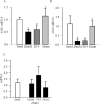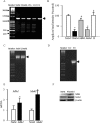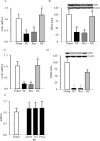Retinal mitochondrial DNA mismatch repair in the development of diabetic retinopathy, and its continued progression after termination of hyperglycemia
- PMID: 25249609
- PMCID: PMC4215746
- DOI: 10.1167/iovs.14-15020
Retinal mitochondrial DNA mismatch repair in the development of diabetic retinopathy, and its continued progression after termination of hyperglycemia
Abstract
Purpose: Mitochondrial DNA (mtDNA) is damaged in the retina in diabetes, and mitochondria copy numbers are decreased. The displacement-loop (D-loop) of the mtDNA, the region with transcription/replication elements, experiences more damage than other regions of mtDNA. Our aim was to examine the role of DNA mismatch repair (MMR) in mitochondria homeostasis in diabetic retinopathy, and in its continued progression after cessation of hyperglycemia.
Methods: Effect of hyperglycemia on sequence variants in the D-loop region was investigated in retinal endothelial cells and in the retina from streptozotocin-induced diabetic rats using mismatch-specific surveyor nuclease. The role of MMR machinery in mtDNA damage and mitochondrial respiration was investigated in retinal endothelial cells overexpressing Mlh1, an MMR enzyme mainly associated with mtDNA polymerase gamma, or Msh2 (associated with nuclear polymerase beta).
Results: Hyperglycemia increased sequence variants in the D-loop region. While overexpression of Mlh1 in endothelial cells ameliorated glucose-induced increase in D-loop sequence variants, decrease in respiration rate and increase in apoptosis, overexpression of Msh2 did not protect the mitochondria damage. Termination of hyperglycemia failed to reverse decrease in MMR enzymes and increase in D-loop sequence variants.
Conclusions: Due to a compromised MMR system, the sequence variants in the D-loop region were not repaired, and that resulted in impaired mtDNA transcription. Mitochondria become dysfunctional, and they continued to be dysfunctional even after hyperglycemia was terminated, contributing to the development, and progression of diabetic retinopathy. Thus, strategies targeting mitochondrial MMR machinery could help maintain mitochondria homeostasis, and inhibit the development of diabetic retinopathy and its continued progression.
Keywords: DNA repair; diabetic retinopathy; metabolic memory; mitochondria damage; mtDNA mismatch.
Copyright 2014 The Association for Research in Vision and Ophthalmology, Inc.
Figures






Similar articles
-
Epigenetics and Mitochondrial Stability in the Metabolic Memory Phenomenon Associated with Continued Progression of Diabetic Retinopathy.Sci Rep. 2020 Apr 20;10(1):6655. doi: 10.1038/s41598-020-63527-1. Sci Rep. 2020. PMID: 32313015 Free PMC article.
-
Damaged mitochondrial DNA replication system and the development of diabetic retinopathy.Antioxid Redox Signal. 2012 Aug 1;17(3):492-504. doi: 10.1089/ars.2011.4333. Epub 2012 Feb 17. Antioxid Redox Signal. 2012. PMID: 22229649 Free PMC article.
-
Role of mitochondria biogenesis in the metabolic memory associated with the continued progression of diabetic retinopathy and its regulation by lipoic acid.Invest Ophthalmol Vis Sci. 2011 Nov 11;52(12):8791-8. doi: 10.1167/iovs.11-8203. Invest Ophthalmol Vis Sci. 2011. PMID: 22003111 Free PMC article.
-
Mitochondria damage in the pathogenesis of diabetic retinopathy and in the metabolic memory associated with its continued progression.Curr Med Chem. 2013;20(26):3226-33. doi: 10.2174/09298673113209990029. Curr Med Chem. 2013. PMID: 23745551 Free PMC article. Review.
-
Oxidative stress and epigenetic modifications in the pathogenesis of diabetic retinopathy.Prog Retin Eye Res. 2015 Sep;48:40-61. doi: 10.1016/j.preteyeres.2015.05.001. Epub 2015 May 12. Prog Retin Eye Res. 2015. PMID: 25975734 Free PMC article. Review.
Cited by
-
Diabetic Retinopathy: Mitochondria Caught in a Muddle of Homocysteine.J Clin Med. 2020 Sep 19;9(9):3019. doi: 10.3390/jcm9093019. J Clin Med. 2020. PMID: 32961662 Free PMC article. Review.
-
Development of novel quality control material based on CRISPR/Cas9 editing and xenografts for MLH1 protein deficiency testing.J Clin Lab Anal. 2021 May;35(5):e23746. doi: 10.1002/jcla.23746. Epub 2021 Apr 7. J Clin Lab Anal. 2021. PMID: 33826163 Free PMC article.
-
DNA Methylation-a Potential Source of Mitochondria DNA Base Mismatch in the Development of Diabetic Retinopathy.Mol Neurobiol. 2019 Jan;56(1):88-101. doi: 10.1007/s12035-018-1086-9. Epub 2018 Apr 21. Mol Neurobiol. 2019. PMID: 29679259
-
The emerging relationship between metabolism and DNA repair.Cell Cycle. 2021 May;20(10):943-959. doi: 10.1080/15384101.2021.1912889. Epub 2021 Apr 20. Cell Cycle. 2021. PMID: 33874857 Free PMC article. Review.
-
Nuclear Genome-Encoded Long Noncoding RNAs and Mitochondrial Damage in Diabetic Retinopathy.Cells. 2021 Nov 23;10(12):3271. doi: 10.3390/cells10123271. Cells. 2021. PMID: 34943778 Free PMC article.
References
-
- Kowluru RA, Abbas SN. Diabetes-induced mitochondrial dysfunction in the retina. Invest Ophthalmol Vis Sci. 2003; 44: 5327–5334 - PubMed
-
- Kanwar M, Chan PS, Kern TS, Kowluru RA. Oxidative damage in the retinal mitochondria of diabetic mice: possible protection by superoxide dismutase. Invest Ophthalmol Vis Sci. 2007; 48: 3805–3811 - PubMed
-
- Brownlee M. The pathobiology of diabetic complications: a unifying mechanism. Diabetes. 2005; 54: 1615–1625 - PubMed
-
- Stuart JA, Brown MF. Mitochondrial DNA maintenance and bioenergetics. Biochim Biophys Acta. 2006; 1757: 79–89 - PubMed
Publication types
MeSH terms
Substances
Grants and funding
LinkOut - more resources
Full Text Sources
Other Literature Sources
Medical

